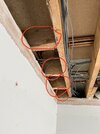Hi all,
Have searched for this and can't find the answer but probably not using the right terminology!
I'm aware of the various regulations about making holes/notches in joists, the number that you're allowed to do, size, distance from top/bottom/end etc. What I'm not clear of, is what, if any, are the regulations for any part of the joist that 'cantilevers' over the load bearing wall that the joists are sat on? Or, do the same regulations apply?
These are the types of joists in question. On the other side of this wall they span a room of c.3.5m wide and are bearing straight into an external cavity wall at the other end. We've got a whole load of pipes to run for heating renovation, ASHP etc and this would be an ideal route to follow. We could run in the "next" joist along (that runs perpendicular), but that would necessitate too many holes in a different joist elsewhere, so we want to "spread the load" as it were.
Hope that makes sense!
Thanks in advance for any advice.
Have searched for this and can't find the answer but probably not using the right terminology!
I'm aware of the various regulations about making holes/notches in joists, the number that you're allowed to do, size, distance from top/bottom/end etc. What I'm not clear of, is what, if any, are the regulations for any part of the joist that 'cantilevers' over the load bearing wall that the joists are sat on? Or, do the same regulations apply?
These are the types of joists in question. On the other side of this wall they span a room of c.3.5m wide and are bearing straight into an external cavity wall at the other end. We've got a whole load of pipes to run for heating renovation, ASHP etc and this would be an ideal route to follow. We could run in the "next" joist along (that runs perpendicular), but that would necessitate too many holes in a different joist elsewhere, so we want to "spread the load" as it were.
Hope that makes sense!
Thanks in advance for any advice.


